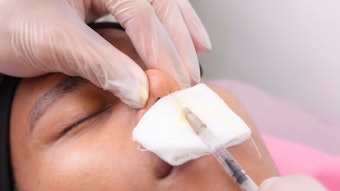
The zygomatico-orbital artery poses the greatest risk when injecting dermal filles in the temporal region. To help reduce the risk of serious adverse event, researchers performed a study to provide the precise position, detailed course and relationship with surrounding structures of the zygomatico-orbital artery. Their findings were published in the Journal of Plastic and Reconstructive Surgery (July 2021).
Related: Ultrasound Improves Safety of Lipofilling Treatment
The study included 58 patients, who underwent head contrast-enhanced three-dimensional computed tomography, and 10 fresh frozen cadavers. The zygomatico-orbital artery was identified in 93% of the samples in this study. Ninety-four percent of the zygomatico-orbital arteries derived directly from the superficial temporal artery (Type 1), and the remaining arteries started from the frontal branch of the superficial temporal artery (Type 2).
Related: [Technique] Botulinum Toxin Injection for Masseter Reduction
The investigators found that the trunk of the zygomatico-orbital artery was located between the deep temporal fascia and the superficial temporal fascia. Deep branches of the zygomatico-orbital artery pierced the superficial layer of the deep temporal fascia.
Related: Reducing Risks of HA Filler-induced Vascular Complications
The zygomatico-orbital artery originated from 11.3 mm in front of the midpoint of the apex of the tragus, and most of its trunks were located less than 20.0 mm above the zygomatic arch. The mean diameter of the zygomatico-orbital artery was 1.2 ± 0.2 mm. There were extensive anastomoses betweent the zygomatico-orbital artery and various periorbital arteries at the lateral orbital rim.
Related: Variations of the Angular Artery in the Midface
The authors posited that the precise anatomical knowledge of the zygomatico-orbital artery described in this study could help cosmetic physicians improve the safety of temporal augmentation.











